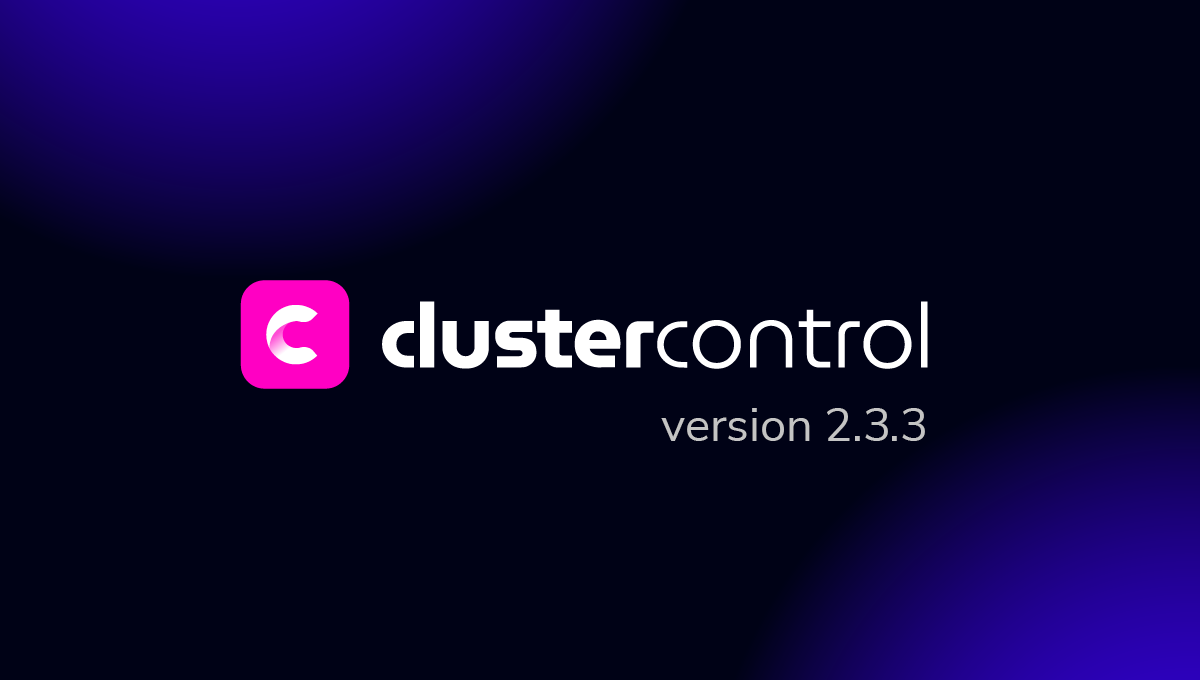blog
How to Secure Galera Cluster – 8 Tips

As a distributed database system, Galera Cluster requires additional security measures as compared to a centralized database. Data is distributed across multiple servers or even datacenters perhaps. With significant data communication happening across nodes, there can be significant exposure if the appropriate security measures are not taken.
In this blog post, we are going to look into some tips on how to secure our Galera Cluster. Note that this blog builds upon our previous blog post – How to Secure Your Open Source Databases with ClusterControl.
Firewall & Security Group
The following ports are very important for a Galera Cluster:
- 3306 – MySQL
- 4567 – Galera communication and replication
- 4568 – Galera IST
- 4444 – Galera SST
From the external network, it is recommended to only open access to MySQL port 3306. The other three ports can be closed down from the external network, and only allows them for internal access between the Galera nodes. If you are running a reverse proxy sitting in front of the Galera nodes, for example HAProxy, you can lock down the MySQL port from public access. Also ensure the monitoring port for the HAProxy monitoring script is opened. The default port is 9200 on the Galera node.
The following diagram illustrates our example setup on a three-node Galera Cluster, with an HAProxy facing the public network with its related ports:

Based on the above diagram, the iptables commands for database nodes are:
$ iptables -A INPUT -p tcp -s 10.0.0.0/24 --dport 3306 -j ACCEPT
$ iptables -A INPUT -p tcp -s 10.0.0.0/24 --dport 4444 -j ACCEPT
$ iptables -A INPUT -p tcp -s 10.0.0.0/24 --dports 4567:4568 -j ACCEPT
$ iptables -A INPUT -p tcp -s 10.0.0.0/24 --dport 9200 -j ACCEPTWhile on the load balancer:
$ iptables -A INPUT -p tcp --dport 3307 -j ACCEPTMake sure to end your firewall rules with deny all, so only traffic as defined in the exception rules is allowed. You can be stricter and extend the commands to follow your security policy – for example, by adding network interface, destination address, source address, connection state and what not.
MySQL Client-Server Encryption
MySQL supports encryption between the client and the server. First we have to generate the certificate. Once configured, you can enforce user accounts to specify certain options to connect with encryption to a MySQL server.


The steps require you to:
- Create a key for Certificate Authority (ca-key.pem)
- Generate a self-signed CA certificate (ca-cert.pem)
- Create a key for server certificate (server-key.pem)
- Generate a certificate for server and sign it with ca-key.pem (server-cert.pem)
- Create a key for client certificate (client-key.pem)
- Generate a certificate for client and sign it with ca-key.pem (client-cert.pem)
Always be careful with the CA private key (ca-key.pem) – anybody with access to it can use it to generate additional client or server certificates that will be accepted as legitimate when CA verification is enabled. The bottom line is all the keys must be kept discreet.
You can then add the SSL-related variables under [mysqld] directive, for example:
ssl-ca=/etc/ssl/mysql/ca-cert.pem
ssl-cert=/etc/ssl/mysql/server-cert.pem
ssl-key=/etc/ssl/mysql/server-key.pemRestart the MySQL server to load the changes. Then create a user with the REQUIRE SSL statement, for example:
mysql> GRANT ALL PRIVILEGES ON db1.* TO 'dbuser'@'192.168.1.100' IDENTIFIED BY 'mySecr3t' REQUIRE SSL;The user created with REQUIRE SSL will be enforced to connect with the correct client SSL files (client-cert.pem, client-key.pem and ca-cert.pem).
With ClusterControl, client-server SSL encryption can easily be enabled from the UI, using the “Create SSL Encryption” feature.
Galera Encryption
Enabling encryption for Galera means IST will also be encrypted because the communication happens via the same socket. SST, on the other hand, has to be configured separately as shown in the next section. All nodes in the cluster must be enabled with SSL encryption and you cannot have a mix of nodes where some have enabled SSL encryption, and others not. The best time to configure this is when setting up a new cluster. However, if you need to add this on a running production system, you will unfortunately need to rebootstrap the cluster and there will be downtime.

All Galera nodes in the cluster must use the same key, certificate and CA (optional). You could also use the same key and certificate created for MySQL client-server encryption, or generate a new set for this purpose only. To activate encryption inside Galera, one has to append the option and value under wsrep_provider_options inside the MySQL configuration file on each Galera node. For example, consider the following existing line for our Galera node:
wsrep_provider_options = "gcache.size=512M; gmcast.segment=0;"Append the related variables inside the quote, delimited by a semi-colon:
wsrep_provider_options = "gcache.size=512M; gmcast.segment=0; socket.ssl_cert=/etc/mysql/cert.pem; socket.ssl_key=/etc/mysql/key.pem;"For more info on the Galera’s SSL related parameters, see here. Perform this modification on all nodes. Then, stop the cluster (one node at a time) and bootstrap from the last node that shut down. You can verify if SSL is loaded correctly by looking into the MySQL error log:
2018-01-19T01:15:30.155211Z 0 [Note] WSREP: gcomm: connecting to group 'my_wsrep_cluster', peer '192.168.10.61:,192.168.10.62:,192.168.10.63:'
2018-01-19T01:15:30.159654Z 0 [Note] WSREP: SSL handshake successful, remote endpoint ssl://192.168.10.62:53024 local endpoint ssl://192.168.10.62:4567 cipher: AES128-SHA compression:With ClusterControl, Galera Replication encryption can be easily enabled using the “Create SSL Galera Encryption” feature.

SST Encryption
When SST happens without encryption, the data communication is exposed while the SST process is ongoing. SST is a full data synchronization process from a donor to a joiner node. If an attacker was able to “see” the full data transmission, the person would get a complete snapshot of your database.

SST with encryption is supported only for mysqldump and xtrabackup-v2 methods. For mysqldump, the user must be granted with “REQUIRE SSL” on all nodes and the configuration is similar to standard MySQL client-server SSL encryption (as described in the previous section). Once the client-server encryption is activated, create a new SST user with SSL enforced:
mysql> GRANT ALL ON *.* TO 'sst_user'@'%' IDENTIFIED BY 'mypassword' REQUIRE SSL;For rsync, we recommend using galera-secure-rsync, a drop-in SSL-secured rsync SST script for Galera Cluster. It operates almost exactly like wsrep_sst_rsync except that it secures the actual communications with SSL using socat. Generate the required client/server key and certificate files, copy them to all nodes and specify the “secure_rsync” as the SST method inside the MySQL configuration file to activate it:
wsrep_sst_method=secure_rsyncFor xtrabackup, the following configuration options must be enabled inside the MySQL configuration file under [sst] directive:
[sst]
encrypt=4
ssl-ca=/path/to/ca-cert.pem
ssl-cert=/path/to/server-cert.pem
ssl-key=/path/to/server-key.pemDatabase restart is not necessary. If this node is selected by Galera as a donor, these configuration options will be picked up automatically when Galera initiates the SST.
SELinux
Security-Enhanced Linux (SELinux) is an access control mechanism implemented in the kernel. Without SELinux, only traditional access control methods such as file permissions or ACL are used to control the file access of users.
By default, with strict enforcing mode enabled, everything is denied and the administrator has to make a series of exceptions policies to the elements of the system require in order to function. Disabling SELinux entirely has become a common poor practice for many RedHat based installation nowadays.
Depending on the workloads, usage patterns and processes, the best way is to create your own SELinux policy module tailored for your environment. What you really need to do is to set SELinux to permissive mode (logging only without enforce), and trigger events that can happen on a Galera node for SELinux to log. The more extensive the better. Example events like:
- Starting node as donor or joiner
- Restart node to trigger IST
- Use different SST methods
- Backup and restore MySQL databases using mysqldump or xtrabackup
- Enable and disable binary logs
One example is if the Galera node is monitored by ClusterControl and the query monitor feature is enabled, ClusterControl will enable/disable the slow query log variable to capture the slow running queries. Thus, you would see the following denial in the audit.log:
$ grep -e denied audit/audit.log | grep -i mysql
type=AVC msg=audit(1516835039.802:37680): avc: denied { open } for pid=71222 comm="mysqld" path="/var/log/mysql/mysql-slow.log" dev="dm-0" ino=35479360 scontext=system_u:system_r:mysqld_t:s0 tcontext=unconfined_u:object_r:var_log_t:s0 tclass=fileThe idea is to let all possible denials get logged into the audit log, which later can be used to generate the policy module using audit2allow before loading it into SELinux. Codership has covered this in details in the documentation page, SELinux Configuration.
SST Account and Privileges
SST is an initial syncing process performed by Galera. It brings a joiner node up-to-date with the rest of the members in the cluster. The process basically exports the data from the donor node and restores it on the joiner node, before the joiner is allowed to catch up on the remaining transactions from the queue (i.e., those that happened during the syncing process). Three SST methods are supported:
- mysqldump
- rsync
- xtrabackup (or xtrabackup-v2)
For mysqldump SST usage, the following privileges are required:
- SELECT, SHOW VIEW, TRIGGER, LOCK TABLES, RELOAD, FILE
We are not going to go further with mysqldump because it is probably not often used in production as SST method. Beside, it is a blocking procedure on the donor. Rsync is usually a preferred second choice after xtrabackup due to faster syncing time, and less error-prone as compared to mysqldump. SST authentication is ignored with rsync, therefore you may skip configuring SST account privileges if rsync is the chosen SST method.
Moving along with xtrabackup, the following privileges are advised for standard backup and restore procedures based on the Xtrabackup documentation page:
- CREATE, CREATE TABLESPACE, EVENT, INSERT, LOCK TABLE, PROCESS, RELOAD, REPLICATION CLIENT, SELECT, SHOW VIEW, SUPER
However for xtrabackup’s SST usage, only the following privileges matter:
- PROCESS, RELOAD, REPLICATION CLIENT
Thus, the GRANT statement for SST can be minimized as:
mysql> GRANT PROCESS,RELOAD,REPLICATION CLIENT ON *.* TO 'sstuser'@'localhost' IDENTIFIED BY 'SuP3R@@sTr0nG%%P4ssW0rD';Then, configure wsrep_sst_auth accordingly inside MySQL configuration file:
wsrep_sst_auth = sstuser:SuP3R@@sTr0nG%%P4ssW0rDOnly grant the SST user for localhost and use a strong password. Avoid using root user as the SST account, because it would expose the root password inside the configuration file under this variable. Plus, changing or resetting the MySQL root password would break SST in the future.
MySQL Security Hardening
Galera Cluster is a multi-master replication plugin for InnoDB storage engine, which runs on MySQL and MariaDB forks. Therefore, standard MySQL/MariaDB/InnoDB security hardening recommendations apply to Galera Cluster as well.
This topic has been covered in numerous blog posts out there. We have also covered this topic in the following blog posts:
- Ten Tips on How to Achieve MySQL and MariaDB Security
- ClusterControl Tips & Tricks: Securing your MySQL Installation
- How to Secure Your Open Source Databases with ClusterControl
The above blog posts summarize the necessity of encrypting data at rest and data in transit, having audit plugins, general security guidelines, network security best practices and so on.
Use a Load Balancer
There are a number of database load balancers (reverse proxy) that can be used together with Galera – HAProxy, ProxySQL and MariaDB MaxScale to name some of them. You can set up a load balancer to control access to your Galera nodes. It is a great way of distributing the database workload between the database instances, as well as restricting access, e.g., if you want to take a node offline for maintenance, or if you want to limit the number of connections opened on the Galera nodes. The load balancer should be able to queue connections, and therefore provide some overload protection to your database servers.
ProxySQL, a powerful database reverse-proxy which understands MySQL and MariaDB, can be extended with many useful security features like query firewall, to block offending queries from the database server. The query rules engine can also be used to rewrite bad queries into something better/safer, or redirect them to another server which can absorb the load without affecting any of the Galera nodes. MariaDB MaxScale also capable of blocking queries based on regular expressions with its Database Firewall filter.
Another advantage having a load balancer for your Galera Cluster is the ability to host a data service without exposing the database tier to the public network. The proxy server can be used as the bastion host to gain access to the database nodes in a private network. By having the database cluster isolated from the outside world, you have removed one of the important attacking vectors.
That’s it. Always stay secure and protected.




